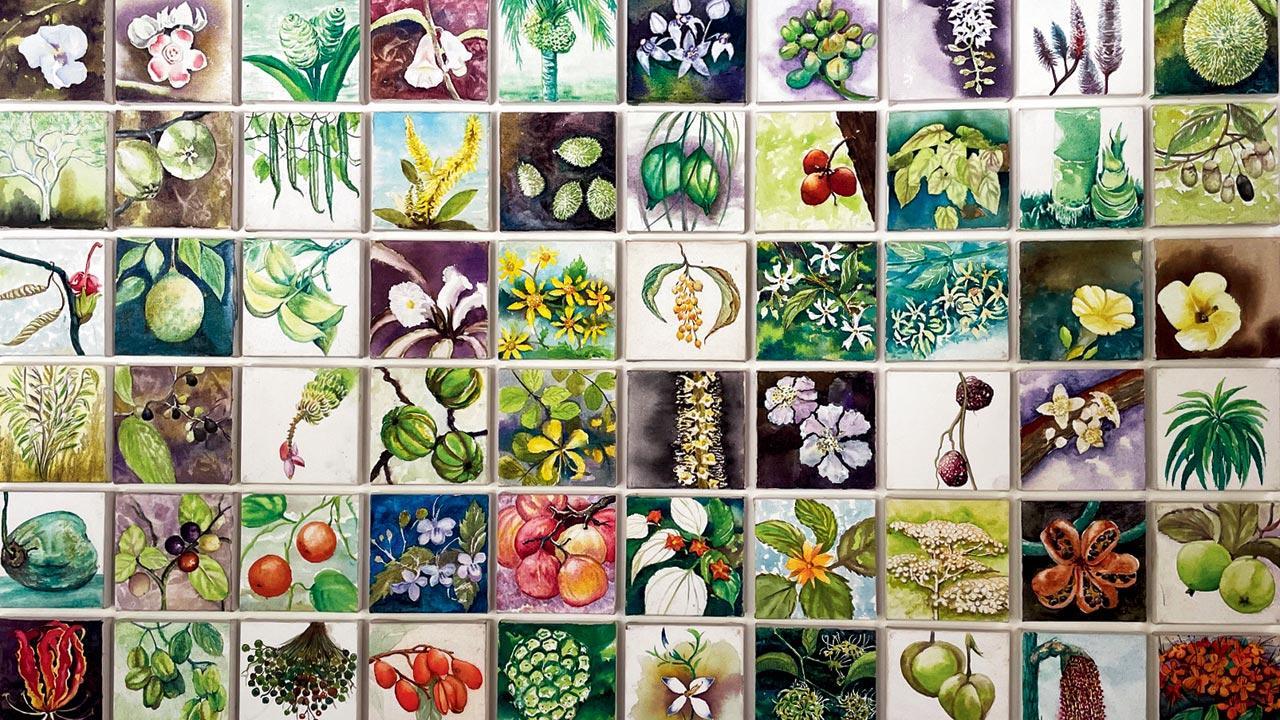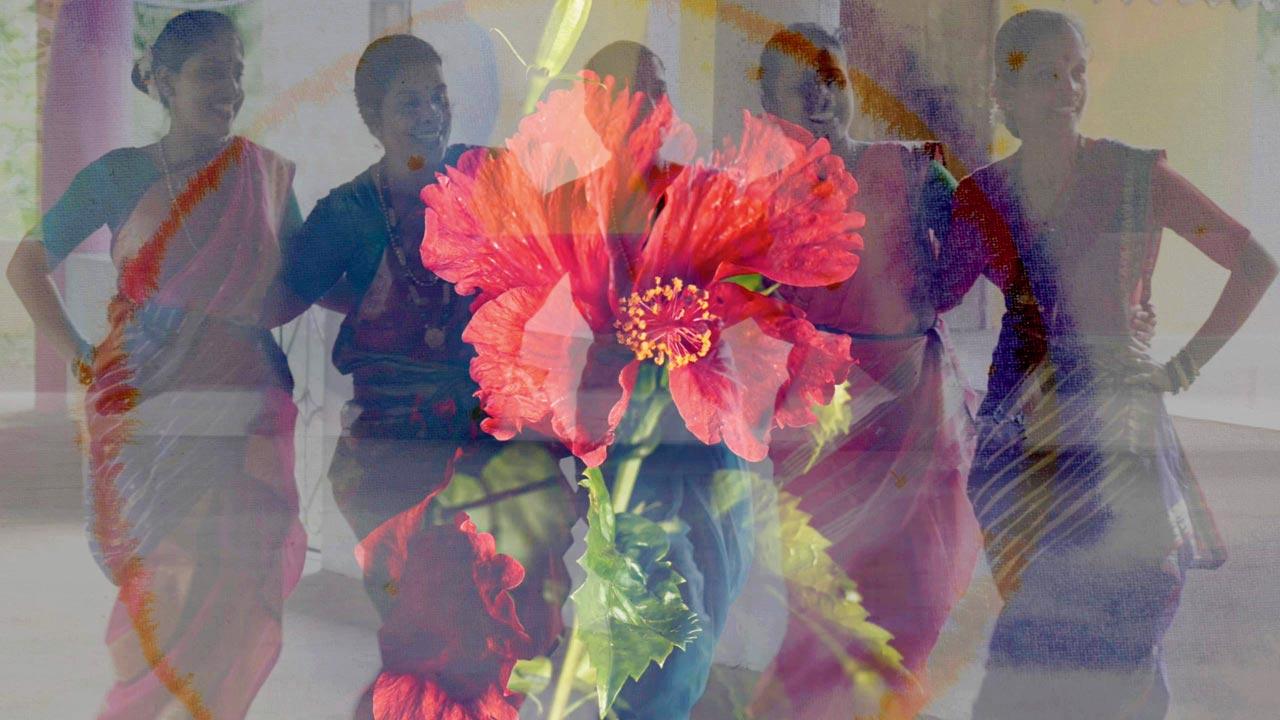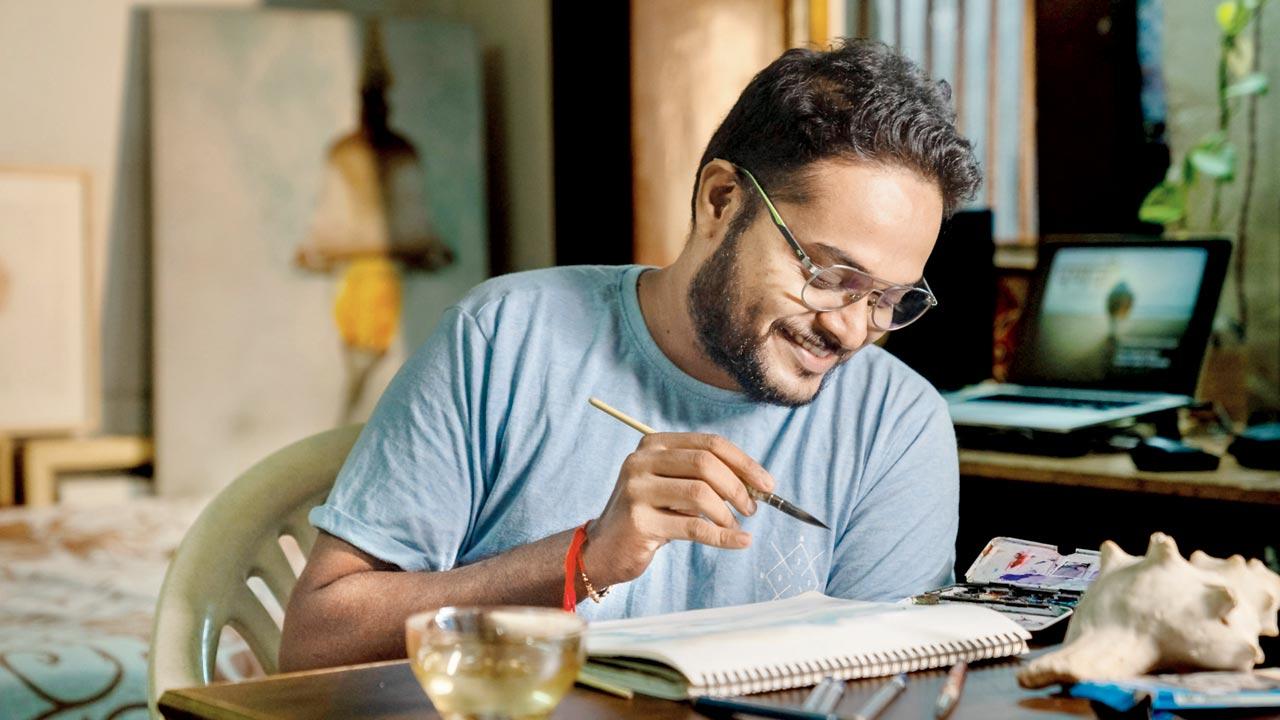A Goan artist uses video and visuals to evoke memories of a festival once rooted in nature

Divesh Gadekar’s water colour canvas paintings and video installation at the exhibition underline the personal sense of loss in the context of the fast-disappearing organic elements that once characterised the festival
![]() The red hibiscus flower has an unmissable iconic value in Lord Ganesha’s worship. Be it the ongoing annual 11-day festival, or the everyday pooja—the large hibiscus petals add grandeur to the Ganpati idol.
The red hibiscus flower has an unmissable iconic value in Lord Ganesha’s worship. Be it the ongoing annual 11-day festival, or the everyday pooja—the large hibiscus petals add grandeur to the Ganpati idol.
ADVERTISEMENT
For a moment, imagine stop-motion animation of a blooming hibiscus flower projected on a screen—seasonal decorations juxtaposed with glimpses of women enjoying the fugdi folk dance running in a loop video. What if these motifs are placed (literally) under a green leafy roof. Surely the video installation would evoke glimpses of the traditional Chovoth (Ganesh Chaturthi) celebration in Goan Hindu homes—a time for community bonding amid nature’s finery—flowers, pods, fruits, lush vegetables and fresh air to top it all.
For visual artist Divesh Gadekar, 34, born and raised in Panaji, the Sunaparanta Goa Centre for the Arts is an apt setting to reimagine the traditional Ganesha festival as he has experienced since his childhood in the village. For the artist, the seasonal biodiverse decorative canopy above a Ganapati idol—called matoli in Goa—symbolises the rich local flora, the essence of the festival.
 Stop-motion animation of a blooming hibiscus flower projected on a screen juxtaposed with glimpses of women enjoying folk dances in a loop video at the ongoing Time, Space, Memory exhibition
Stop-motion animation of a blooming hibiscus flower projected on a screen juxtaposed with glimpses of women enjoying folk dances in a loop video at the ongoing Time, Space, Memory exhibition
Gadekar’s work on display, as part of the Time, Space Memory exhibition, falls in the exact Ganpati festival weeks. The 60 water colour canvas paintings and the video installation broadly underline a personal sense of loss in the context of the fast-disappearing organic elements that once characterised the festival. For an artist like Gadekar, who has grown in the open green spaces of Goa, particularly the sylvan Mahalakshmi temple precincts in Panaji, the festival is about a life rhythm. It’s about folk dances (fugdi), instruments (ghumat), lesser-known leafy vegetables (kanakicho kom) and fruits (kavandal). In fact, he feels each frame of his Maati Dev (Mud God) exhibition “is a reminder of the little natural joys [hisbiscus/jaswandi included] the festival ushered in, as against the high decibel synthetic stuff it is now associated with”.
Attached to his ancestral family in Siolim (North Goa), Gadekar yearned for the Ganesh festivities since school days, as they signalled a freedom from the routine. “I was weak in every subject, not just Math,” he shares. “So getting away from school was welcome. I had a natural affinity for decoration craft, percussion, Ghumat aartis and the family reunion rituals.” The Ganesh season presented opportunities for pure fun, which later propelled Gadekar towards visual arts. Gadekar was also super-enthusiastic about Shigmotsav (spring festival in Goa celebrated by the Konkani diaspora) and Diwali too. His father, a road contractor, played the conch with immaculate ease. Gadekar would be allowed a smaller conch, whenever the father performed in the temple. The conch later became central to his art; it is soon to resurface in one of his upcoming public art projects.
As apparent in the Time, Space Memory exhibition, Gadekar deeply regrets the current “political” nature of the Ganesh festivities. “Huge Plaster of Paris idols and the length of the garland firecracker ‘ladi’ determines the prestige of the public-private Ganesh mandals, whether in Goa or Maharashtra. I find that festivals come and go, but harmony remains elusive,” the artist laments, adding that Time, Space Memory gives him a chance to articulate his sentiments. He feels artists should at least underline the current jarring state of festivities, especially the immersion ceremonies, which mercilessly annihilate water bodies. “The festival resembles a corporate contest in which mega-sized idols and pandals contribute to a fierce annual jamboree.”
 Divesh Gadekar
Divesh Gadekar
Gadekar’s art is vocal about environment conservation—as manifested in the animated video, which follows the hibiscus and a clay idol emerging from and dissolving in Mother Earth; the canvas paintings capture the glory of the hibiscus in water colours. The artist not just celebrates the greens (flowers and fruits) associated with the season, but decodes each element of the matoli in a QR coded public exhibit for the uninitiated—a fruit named bede (Areca Catechu) used for treatment of schizophrenia and glaucoma; the seetechi veni (Rhynchostylis) flower which helps fight asthama, epileptic spasms and menstrual disorders.
As curator of the Time, Space Memory exhibition, Leandre D’Souza says, Gadekar uses the moving image as a tool of aesthetic enquiry. “Divesh’s work is deeply connected to and impacted by his immediate environment. He presents the Gana-pati [the people’s God] an agricultural deity, formed out of clay. The decorative canopy [matoli] is believed to transmit knowledge about the local biodiversity from one generation to another.”
D’Souza feels the elements from Goan culture transform the exhibition space into a space for reflection on nature’s fragility.
Gadekar is also constantly ideating on research projects that dwell on linkages between natural surroundings and community life. For instance, he is now researching two local musical instruments made out of dried hollow bamboo—pawa and surpawa—used by the Dhangar (shepherd) tribal community in Goa (Ponda and Sanguem), Maharashtra (Konkan) and northern Karnataka. He feels the instruments are introductions to a vanishing lifestyle. “Every musical instrument has its own language. Also, the sound of a particular instrument can describe the tone and tenor of a language,” says Gadekar. For him, the Dhangar community’s participation is central to understanding the sound and the aesthetics of the instrument, which is indigenously designed to calm aggressive or disturbed cattle/animals, and lead them back into the herd. It is also part of year-long rituals, Dusshera being the focal point, and of specific interest to him.
Gadekar believes in speaking the inconvenient truth. He feels artists have to be proactive in presenting local heritage and history in perspective. “Whether it’s the Ganapati festival or a dying musical instrument or the integration of local flora in everyday rituals, the artist community has to state whatever the situation is. We have to underscore the harm done to the environment in the name of culture and religion.” His past exhibitions—Maati: Morphing landscapes (Sadhana Dell’Arte), Entangled (Walkin Studios, Bengaluru), Unravelling Stories (as part of a fellowship) and the Goa Familia Project, speak of his single-minded pursuit of roots. In 2018, he won the Fundação Oriente Visual Arts Award for his continual explorations. Interestingly, Gadekar’s studio in Panaji—where he brainstorms—is called Suru, which translates to “start”. For him, beginnings are about celebration of the local ecology.
Sumedha Raikar-Mhatre is a culture columnist in search of the sub-text. You can reach her at sumedha.raikar@mid-day.com
 Subscribe today by clicking the link and stay updated with the latest news!" Click here!
Subscribe today by clicking the link and stay updated with the latest news!" Click here!







